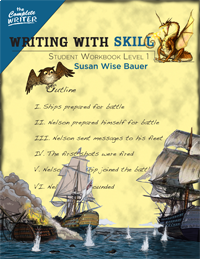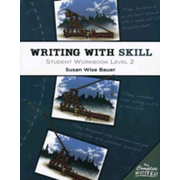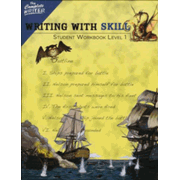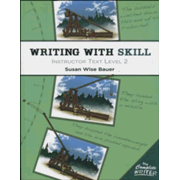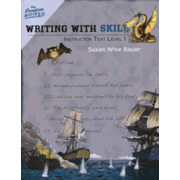The Writing With Skill (WWS) series continues The Complete Writer series that began with four courses for grades 1 through 4 titled Writing With Ease. Writing With Skill Level One is the first of four courses that target grades five through eight, although they might be used with older students who have not yet developed their composition skills. While developing composition skills is the primary goal, reading comprehension and analysis also receive a great deal of attention.
For each course, there are a student workbook and an instructor text. (Both are available in either print or downloadable PDF formats.) Unlike Writing With Ease, WWS is designed for students to complete a significant amount of their work independently but not all. Parents might need to work with students to help them develop independent study skills so that they take the time to complete those parts of the lesson properly rather than skimming over instructions or questions.
The instructor text provides the parent with the student's instructions so the parent knows what the student is supposed to do. However, it also adds suggestions for the parent if a student is struggling with a particular assignment. For example, if a student has trouble identifying main events as they take notes for a narration, the instructor text provides some leading questions a parent might use to help their child tune into the main events rather than the details.
While students might complete much of their work independently, the parent or teacher plays an important role. He or she needs to ensure that students understand lessons, assist them as directed with some activities, lead discussions, provide extra assistance as directed in the instructor text, provide students with the rubrics, and check student work according to the rubrics. To accomplish this, the parent or teacher needs to read through each lesson in advance. The instructor text has teaching instructions as well as the content of the student book except for the literary pieces. The parent or teacher needs to refer to the student book to read the literary works.
The instructor text for Level One is a hefty 607 pages, so you can see that teaching the course requires a substantial time commitment just to prepare for each lesson. However, lessons are laid out in a step-by-step fashion that should make it easy for both student and teacher/parent to understand what is to be done. The occasional discussions are often scripted with questions to read plus suggested answers. Examples of composition work are provided so that the teacher or parent has a clear idea of what to expect from each assignment.
The detailed lesson instructions are helpful, although I suspect it might become cumbersome to read along in the instructor text through the teaching instruction at times when you are interacting with a student. Advance preparation might allow you to set the guide aside and work more casually with your student, but you would have to become thoroughly familiar with the lesson to do so.
Specific rubrics are included in the instructor text for each of the various forms of composition. Rubrics specify expectations, but these are not grading or recording forms. Susan Wise Bauer explains in the instructor text, “ In my opinion, giving a “grade” is not useful at this level. Use the rubric to decide whether the student has done an adequate job by following the instructions for the assignment. If the student has not followed the instructions, show him specifically where his composition falls short, and ask him to revise the assignment” (Level One, p. xxiv).
Each course should take one school year to complete. Courses are designed with lessons for four days per week. Students might progress more quickly or more slowly depending upon their ability. Parents might also tailor the assignments themselves to make them more appropriate for a student— tailoring such as requiring a shorter or longer composition.
Students are encouraged to use a word processing program, but parents should pay attention to the instruction guide when it says that grammar and spell check options in the program must be turned off so that they don't become a crutch for students at a stage where they need to be developing their own editing skills.
Students create a composition notebook in a three-ring binder that is divided into six sections to use with each course. Students will need a comprehensive thesaurus for use throughout all of the courses.
Level One of (WWS) teaches paragraph construction, topic sentences, note taking, writing narrative summaries, outlines, word choices and the use of a thesaurus, chronological narratives (particularly from science and history), descriptions of places, scientific descriptions, descriptions of people, biographical sketches, literary criticism applied to prose, literary criticism applied to poetry, and researching, footnoting, and citing works that were used. Students apply research skills and documentation in brief compositions then write a thousand-word researched composition at the end of the year.
While at first this might sound a bit dry and demanding for students at fifth grade level, it really isn’t because students frequently use literary excerpts as source material for the activities. These vary from a few paragraphs or stanzas to two or three pages in length. A few lengthier literary works such as “Rikki-Tikki-Tavi” from The Jungle Book run as long as ten pages; these are in an appendix rather than within the pertinent lessons. Sources might be used in unusual ways. For example, Sir Arthur Conan Doyle’s The Hound of the Baskervilles is used as one source from which students work to write scientific descriptions. Some of the literary works are certainly more interesting than others. Some are public domain works on science or history that would be read for information but not for entertainment. Some are from more interestingly-written non-fiction such as Susan Wise Bauer’s Story of the World. In addition to the literary excerpts, the 568-page student book includes some activity pages on which students will write which helps account for the large number of pages.
Note: WWS Level Two is also available but I have not yet reviewed it.
As with other resources from Susan Wise Bauer, the perspective is secular but supportive of a Christian outlook.
Writing With Skill offers substantive instruction in composition—more than you find in most programs for students in the middle grades. You might need to adapt a course to a slower pace if it is too demanding for your child. Keep in mind that students are covering a substantial amount of literature study while developing composition skills. You might omit any other reading or literature program, perhaps having your child instead read some of the complete works from which excerpts are drawn for the lessons. Eliminating the redundancy of another reading program should free up time to fully utilize this course and make the most of the literary connections.




